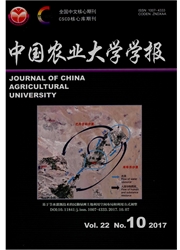

 中文摘要:
中文摘要:
通过研究高油玉米秸秆青贮发酵过程中营养成分和发酵参数变化的动态(试验1),以及青贮浸提液对活体外瘤胃发酵的影响(试验2),初步探明导致高油玉米秸秆青贮提高瘤胃发酵程度的因素。试验1结果显示发酵1周内,可溶性糖损失50%以上,pH降到4.0以下;乳酸含量在6周内逐步升高,而后保持不变,其他营养成分保持稳定;试验2结果表明,添加青贮浸提液后与对照组相比,最大产气量显著增加(P〈0.0001),产气速度加快(P〈0.0001),产气延滞期缩短(P=0.0008)。其中青贮浸提液灭菌处理与否不影响产气动态参数。添加2种青贮浸提液会导致活体外人工瘤胃发酵pH显著降低(P〈0.0001)。对照组活体外瘤胃发酵液中乙酸摩尔分数最低(67.79%),其次为添加未处理浸提液组(78.48%)和灭菌浸提液组(80.19%)。并且3个处理组差异显著(P〈0.0001)。丙酸摩尔分数也差异显著(P〈0.0001),其中对照的丙酸摩尔分数最高。达到21.7696.而其他2个处理组分别为8.81%和6.84%。对照组中异丁酸和异戊酸的摩尔分数均最高。分别为0.66%和0.85%。结果表明。高油玉米秸秆青贮在1周内发酵过程变化很大。发酵6周后。进入稳定阶段。添加青贮浸提液影响活体外瘤胃发酵模式,高油玉米秸秆青贮浸提液的营养成分可能是影响瘤胃微生物发酵的主要因素。
 英文摘要:
英文摘要:
Two experiments using high oil corn (HOC) stovers (variety Qingyou # 1) were designed to examine the dynamic characteristics of ensilage fermentation (Exp. 1) and to determine the effect of addition of silage slurry on rumen fermentation parameters of HOC stovers based on in vitro gas production method (Exp. 2). In Exp 1, triplicate jars were opened at 1, 3, 6, 9 weeks postfilling. In Exp 2, three treatments were used; (1) control (HOC silage + distilled water), (2) HOC silage + silage slurry, (3) HOC silage + sterilized silage slurry. In Exp 1, more than half of WSC was used up within 1 week of ensiling. The pH dropped to 4.0 only after 1 week of ensiling. All nutrients of silage maintained stable after 6 week of ensiling. In Exp 2, addition of silage slurry fluid resulted in higher gas amount (P〈0.000 1) and rate of gas production (P〈0.000 1), and shorter fermentation lag time (P=0.000 8) than control. As silage slurry fluid was added to the in vitro fermentation, the ruminal pH (P〈 0. 000 1) decreased (P〈0. 000 1). Molar proportion of acetate increased significantly (67.79, 78.48, 80.19%; P 〈 0. 000 1). There was difference between treatments for molar proportion of propionic acid (P〈 0. 000 1). Molar proportions of isobutyrate (0.66%) and isovalerate (0.85 % ) were higher for control treatment. No difference was found between intact silage slurry and sterilized silage slurry for ruminal fermentation. In conclusion, HOC stover silages went through a rapid fermentation phase, and maintained stable after 6 week postfiling. Silage slurry fluid could affect the ruminal fermentation pattern, and silage fermentation products rather than the microorganisms present in the silage materials might factor that affect ruminal fermentation.
 同期刊论文项目
同期刊论文项目
 同项目期刊论文
同项目期刊论文
 期刊信息
期刊信息
